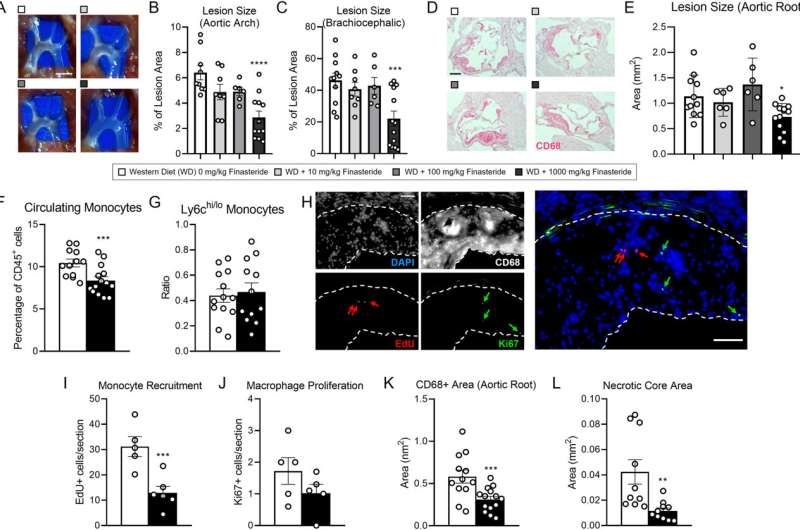This article has been reviewed according to Science X's editorial process and policies. Editors have highlighted the following attributes while ensuring the content's credibility:
fact-checked
trusted source
proofread
Common hair loss and prostate drug may also cut heart disease risk

The drug finasteride, also known as Propecia or Proscar, treats male pattern baldness and enlarged prostate in millions of men worldwide. But a new University of Illinois Urbana-Champaign study suggests the drug may also provide a surprising and life-saving benefit: lowering cholesterol and cutting the overall risk of cardiovascular disease.
The study, published in the Journal of Lipid Research, found significant correlations between finasteride use and lower cholesterol levels in men taking part in the National Health and Nutrition Examination Survey between 2009 and 2016. In mice taking high finasteride doses, the researchers found reductions in total plasma cholesterol, delayed atherosclerosis progression, lower inflammation in the liver, and related benefits.
"When we looked at the men taking finasteride in the survey, their cholesterol levels averaged 30 points lower than men not taking the drug. I thought we'd see the opposite pattern, so it was very interesting," said lead study author Jaume Amengual, assistant professor in the Department of Food Science and Human Nutrition and the Division of Nutritional Sciences, both part of the College of Agricultural, Consumer and Environmental Sciences (ACES) at U. of I.
As exciting as the survey results were, they had their limitations. Of nearly 4,800 survey respondents meeting general health criteria for inclusion in the analysis, only 155, all men over 50, reported using finasteride. And the researchers couldn't tell how much or how long men in the survey had taken the drug.
"This was not a clinical study in which you can control everything perfectly," Amengual said. "It was more of an observation that led us to say, "Okay, now we've seen this in people. Let's see what happens in mice.'"
But first, why would a hair loss and prostate drug affect cholesterol? Amengual studies atherosclerosis, the condition in which cholesterol plaques choke arteries, leading to stroke, heart attack, and other forms of cardiovascular disease. Because the disease is far more common in men than premenopausal women, scientists have long suspected the sex hormone testosterone is important in atherosclerosis, though its role isn't entirely clear.
Finasteride works by blocking a protein found in hair follicles and the prostate gland that activates testosterone. The common thread, testosterone, was enough to pique Amengual's interest.
"I was reading about this medication one day, and I started to notice that there were not many long-term studies of the implications of the drug. Initially, it was just my own curiosity, based on the fact that hormone levels are known to have an effect on atherosclerosis, hair loss, and prostate issues," he said. "So, we decided to dig into it."
After documenting the first-ever link, albeit observational, between finasteride and lower cholesterol in men, Amengual got doctoral student Donald Molina Chaves to see if the pattern held in mice.
Molina Chaves tested four levels of finasteride—0, 10, 100, and 1000 milligrams per kilogram of food—in male mice genetically predisposed to atherosclerosis.
The mice consumed the drug, along with a high-fat, high-cholesterol "Western" diet, for 12 weeks. After the experiment, Molina Chaves analyzed the levels of cholesterol and other lipids in the mice, along with evidence of atherosclerotic plaques. He also tested gene expression in the liver, looked at bile acid metabolism, and analyzed steroids, triglycerides, immune activity, and more.
"Mice that were given a high dose of finasteride showed lower cholesterol levels within the plasma as well as in the arteries," Molina Chaves said. "There were also fewer lipids and inflammatory markers in the liver."
Although the effects were only significant at the highest dose, a level Amengual calls outrageous for humans, he explains that mice metabolize finasteride differently than people.
"It's an incredibly high level of the drug. But we use mice as a model, and they are extremely resistant to things that would kill any of us," he said. "So it is not that crazy when you think about it that way."
Humans take 1-milligram or 5-milligram doses of finasteride daily for hair loss and enlarged prostate, respectively. The fact that a clear pattern showed up in a survey of men likely taking one of these doses suggests the drug may be lowering cholesterol without the megadoses tested in mice.
The next step is for physicians to start tracking cholesterol in finasteride patients or conduct a clinical trial to verify the effect. Amengual says it may be especially important to understand how finasteride affects trans individuals.
"Over the past decade, doctors have started prescribing this drug for individuals transitioning either from male to female or female to male. In both cases, the hormonal changes can trigger hair loss," he said. "The interesting thing is that transgender people are also at a higher risk of cardiovascular diseases. So this drug could have a potential beneficial effect to prevent cardiovascular disease not only in cis men but also in transgender individuals."
Finally, Amengual notes, like any medication, finasteride is not without risk. People should consult their doctors to learn more.
More information: Patrick McQueen et al, Finasteride delays atherosclerosis progression in mice and is associated with a reduction in plasma cholesterol in men, Journal of Lipid Research (2024). DOI: 10.1016/j.jlr.2024.100507




















